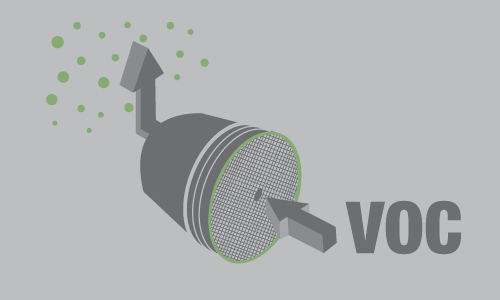Reducing the impact that manufacturing plants have on the environment has become one of the hottest topics of conversation today (Science Daily). Factory owners and managers have to follow EPA-established standards and regulations in order to prevent excess pollutants from entering our atmosphere (EPA). That being said, finding the best way to destroy these emissions is a constant challenge.
While there are many types of VOC abatement systems out there, rotary concentrators offer a great solution for industries that have high exhaust volumes with low concentration levels. In this article, we’ll go over the basics of rotary concentrators, how they work, and why they provide an effective solution when paired with oxidizers.
The Importance of Gas Emission Control and VOC Abatement
Large manufacturing facilities and production plants tend to generate gas emissions known as volatile organic compounds (VOCs) and hazardous air pollutants (HAPs).
These gases enter our atmosphere, contributing to the formation of ozone, smog, and other organic aerosols. At the same time, these pollutants can have a negative impact on the environment and even cause severe health complications in humans.
Because of this, manufacturers and production plants need to implement effective HAP and VOC abatement techniques. However, keep in mind that every factory is different, and the best VOC destruction method will depend heavily on the facility it will be used in.
Introducing Rotary Concentrator Systems with Oxidizers
One of the most important factors when choosing the best VOC abatement method is the exhaust stream volume and pollutant concentration. The larger the exhaust volumes to be treated, the larger the oxidizer must be to destroy the emissions. This is where rotary concentrators come in.
Instead of simply destroying the VOCs in the large airstream, rotary concentrators capture and concentrate the air pollutants. Then, the pollutants in this concentrated and reduced volume airstream are transported to an oxidizer, where VOCs and HAPs are destroyed through oxidation. This reduces the amount of energy needed to treat the exhaust air, lowering your plant’s operating costs while still allowing you to abide by EPA-set regulations.
How Do Rotary Concentrators Work?
Before delving into the specifics of how rotary concentrators work, keep in mind that they can be used to control emissions in an array of industries. That being said, they are most commonly found in the coating, finishing, semi-conductor, paint manufacturing facilities, and similar factories.
Polluted exhaust air is redirected through a zeolite wheel that rotates at a speed of approximately 2 to 8 revolutions per hour. The zeolite wheel collects and absorbs air pollutants, which are then transported and desorbed in a different chamber using a heated air stream. The clean section of the wheel is then returned to the main housing unit in order to adsorb more pollutants and continue the cycle.
The desorbed pollutants, which are now in a concentrated air stream, are typically routed to a regenerative thermal oxidizer (RTO), destroying up to 96% of all VOCs and HAPs.
Benefits of Rotary Concentrator Systems
Reduced Operating Expenses
As the name implies, rotary concentrators concentrate the pollutants in the exhaust stream, so the oxidizer size can be reduced and will not require as much fuel to operate.
Ideal for VOCs and HAPs
Rotary concentrators are usually more effective when combined with RTOs, but they can also be paired with other types of oxidizers. In other words, they present an effective solution to destroy different types of VOCs and HAPs as well.
Compatible with Low Inlet Temperatures
While other oxidizer systems are capable of handling high process exhaust air temperatures, rotary concentrators are generally designed for use with low inlet temperatures. This makes them ideal for the coating and finishing industries because they typically don’t exhaust air at high temperatures but are still able to achieve high energy efficiency by the concentrated airstream.
Getting a Rotary Concentrator System for Your Plant
If your factory has high exhaust volumes with temperature and low pollution concentration, then a rotary concentrator system may be ideal for you. Get in touch with The CMM Group by filling out our online form or giving us a call and find out how a rotary concentrator system can provide the right solution for your facility!




